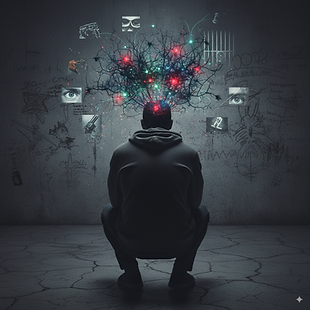
JAPEC COMMUNITY LIFE MAGAZINE
COMMUNTY 1 TV NETWORK

PSYCHOLOGY - EXPLOING CRIMINAL MINDSET
.jpeg)
CLICK TO LISTEN
Important Considerations
The criminal mindset isn't a single, uniform phenomenon. Different types of crimes may involve different psychological patterns. White-collar criminals may have different motivations and thought processes than violent offenders or substance-dependent individuals who commit crimes.
Additionally, many people who engage in criminal behavior don't have fundamentally different brains or personalities from law-abiding citizens. Situational factors, opportunity, and social circumstances all play significant roles.
Understanding criminal thinking helps develop more effective prevention programs, treatment approaches, and policies that address root causes rather than just punishing outcomes.
Core Components of Criminal Thinking
Cognitive Distortions: Many offenders exhibit distorted thinking patterns that justify or rationalize their actions. These include minimizing harm ("It wasn't that bad"), externalizing blame ("Society made me do it"), and viewing themselves as victims rather than perpetrators.
Risk Assessment Deficits: Criminal thinking often involves poor judgment about consequences. This can manifest as impulsivity, inability to consider long-term outcomes, or unrealistic optimism about avoiding detection or punishment.
Moral Disengagement: Psychologist Albert Bandura identified mechanisms people use to disengage from moral standards, such as moral justification, euphemistic labeling, and dehumanizing victims. Criminals may use these to avoid guilt or shame.
Psychological Factors
Antisocial Personality Traits: Some offenders display patterns of disregard for others' rights, lack of empathy, superficial charm, and manipulative behavior. However, not all criminals have antisocial personality disorder.
Emotional Regulation Issues: Difficulty managing anger, frustration, or other intense emotions can contribute to criminal behavior, particularly violent crimes.
Entitlement and Grandiosity: Some offenders have inflated self-perception and believe they deserve special treatment or are above the law.
Environmental and Social Influences
Learned Behavior: Criminal thinking can develop through exposure to criminal role models, peer pressure, or environments where illegal activity is normalized.
Trauma and Adversity: Childhood abuse, neglect, poverty, or other traumatic experiences can shape thinking patterns and increase criminality risk.
Subcultural Values: Some individuals adopt value systems from criminal subcultures that conflict with mainstream social norms.
Important Considerations
The criminal mindset isn't a single, uniform phenomenon. Different types of crimes may involve different psychological patterns. White-collar criminals may have different motivations and thought processes than violent offenders or substance-dependent individuals who commit crimes.
Additionally, many people who engage in criminal behavior don't have fundamentally different brains or personalities from law-abiding citizens. Situational factors, opportunity, and social circumstances all play significant roles.
Understanding criminal thinking helps develop more effective prevention programs, treatment approaches, and policies that address root causes rather than just punishing outcomes.
The Human Element
Behind every crime statistic lies a complex web of human motivations, circumstances, and choices. Criminal behavior often emerges from the intersection of individual psychology, social conditions, economic pressures, and cultural influences. Understanding these factors doesn't excuse harmful behavior, but it provides insight into prevention and rehabilitation strategies.
Some individuals turn to crime out of desperation or perceived necessity, while others are driven by greed, power, or psychological compulsions. Still others find themselves caught in cycles of violence or addiction that make criminal activity seem like the only available option.
Societal Impact
Crime affects not just immediate victims but entire communities. It erodes trust, creates fear, diverts resources from productive activities, and can perpetuate cycles of violence and retribution. The response to crime—through policing, courts, and corrections—represents a significant investment of social resources and reflects our collective values about justice, redemption, and public safety.
The study of criminal behavior continues to evolve as researchers, policymakers, and practitioners seek more effective ways to prevent crime, support victims, and address the root causes of antisocial behavior while maintaining public safety and upholding the rule of law.

.png)


